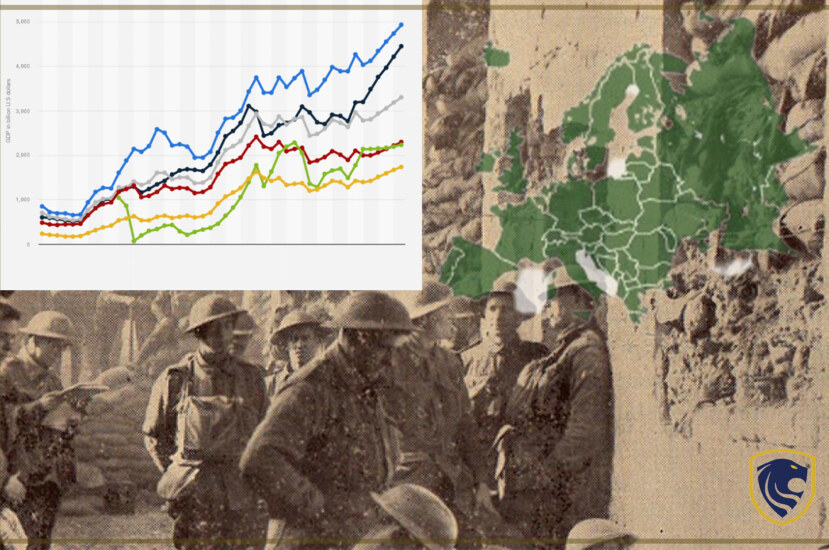The World War 1 lasted for four abhorrent years from 28th July, 1914 to 11th November, 1918. Two groups of countries, namely Allies and the Central powers waged war at their rivalry group. The Allies constituted of the British Empire, France, Belgium, Russia and later, the USA. The countries that included the Central powers were Germany, Austria, Hungary, Bulgaria and Turkey.
The Cause of World War 1
Archduke Franz Ferdinand had been named the successor of the Austro-Hungarian monarchy in 1914s. But Archduke Franz Ferdinand and his wife Sophie were shot to death on June 28, 1914, in Sarajevo. Members of a Serbian nationalist group were responsible for the homicide. His death resulted in an international crisis and ultimately it led to the World War I.
The enraged Austro-Hungarian Empire declared the ultimate resolution that Serbia should put an end to its involvement in Austria-Hungary affairs. Serbia dismissed the demands of Austria-Hungary. In this dispute Austria-Hungary had the backing of Germany and Serbia was supported by Russia. In retribution, Austria-Hungary waged war on Serbia on 28th July, 1914. Russia also partook in the war in support of Serbia.

Germany unleashed war first on Russia, then on France, who was militarily in league with Russia. The German’s actions prompted the Britain to declare war, so the Britain entered war on 4th August, 1914.
In a short span of time, that is after six weeks of Archduke Franz Ferdinand’s assassination, the Europe was ravaged with war.
Negative Effects of War
Europe faced economic hardships as the war was extremely expensive. It is recorded that in September 1918, they had to pay £3.8 million for bullets alone for a day. Germany was the most affected country. Apart from losing the territory, Germany had to pay reparations for destruction caused on Belgium and France.

Rebuilding their nations was an arduous task owing to the immense destructions caused by the war. The raw materials were scarce. And shortage of food was another prevalent problem. The war was left with thousands of refugees and they were homeless. The unemployment was high at the time. Many of the European countries owed money to the United States.
Even though the European countries went through economic recessions after World War 1, the United States spared well. In fact, the USA experienced a significant growth. US banks provided with loans to the Europe. It was due to the fact that the USA joined the war only in 1917 and Europe used to purchase arms for the war from the United States.
Response to economic crisis
As the first step, Britain regulated their currency. For that, tariffs and taxes were increased. The Britain elected a multiparty coalition to preserve democracy. Other countries too maintained democracy.

Consumer economy
It is believed that consumer economy was improved after the world war 1. The soldiers returned to their homes with the hope of beginning a new, prosperous life. New entertainment sources were invented to help them enjoy their new lives. For instance, new inventions such as radio and silent movies were a source of enjoyment and relaxation for the soldiers who returned from the war. Henry Ford’s automobile industry also prospered. Consumer economy is a system where people buy goods and services, instead of producing goods for themselves. And in a consumer economy, an economic motive is always present. The concept of consumer economy existed before the world war1. It became more prevalent after the world war 1.

During this period consumer buying power was increased because of the increase of manufacturing wages. In other words, the payments given for the workers for their labour was increased. In 1914 the average payment for a week was at $11. It was rose to $22 in 1919. This increase of consumer buying power was helpful in restoring the national economy.
Advancement in Technology
The 1920s was regarded as an “age of innovation” as many new inventions came up. There were new productions, new materials that came up with the world war 1. They were of help for the development of economy and wellbeing of people.

The living styles of people changed with the technological advancements, and the improved transportation and communication systems. These changes completely transformed the living styles of people, the way they communicate, and transport modes.
When the world war began in 1914, planes were a new introduction to the people, having the first flight took place only 11 years before. Planes were not common at the time. When the war begun scientists and engineers strived hard to invent planes that are stronger and which can be used in the battlefield. France had only 140 at the start of the war. But at the conclusion of the war, they had 4500 aircrafts.
Freedom of women

As the war erupted, millions of men went for the war creating a void in workforce. So, women had to fill the void created, and they started working in manufacturing and agricultural fields. After the world war 1, men returned. But women had enjoyed the financial freedom and personal freedom. So many women didn’t want to relinquish their freedom, so they continued to work. There were other women, who worked as doctors, ambulance drivers, translators on battlefield. Moreover, the women were actively involved in the war effort. After the war, there were uprisings demanding for the rights of women. Many nations granted the suffrage to the women. So, after the world war 1, women’s contribution for the economy of their nation states was significantly improved.
Multinational corporations

Moreover, multinational corporations opened up subsidiaries in other countries. They got access for raw materials like coco and palm which were plentiful in African countries. Production cost was cheaper as they could borrow raw materials and labour cheaply. So Multinational corporations got huge profits from the overseas branches which helped the economy of their countries.
Agriculture and Medicines
Harvest was increased due to the improved yielding varieties, herbicides and fertilizer. Medical field was improved with the development of new drugs and medical treatments.

Germany
It was Germany that was affected the most. They suffered hyperinflation after the world war 1. Germany too recovered the losses of war. Initially their growth was slow, later on Germany could improve its’ people’s standards of living gradually. They exported local products and ameliorated production of food. Earlier trade was carried out in violation of trade regulations. Later strict laws were imposed. So, the authorities could reduce black market which was created due to the high inflation.
A liberal business- friendly market was created. It was helpful in blooming the industries. A liberal tax financed social security was put in place which would avert worst forms of poverty.

The Dawes committee brought up the ‘Dawes Plan’ to rescue Germany from the difficult situation it was in. Further, the Dawes Pan decreased the effects of the war reparation. This plan included a staggered payment plan that aided the payment of war reparation which Germany had to pay under the recommendations of the Treaty of Versailles.
Also, the ‘Dawes Plan’ put an end to the European diplomacy crisis.
Many Germans considered the Treaty of Versailles unfair and that it was a humiliation for Germany. They had to pay reparation fee. And they had to reduce their military to 100000 troops. By 1939 Germany had recovered from the economic crisis and was stronger than ever.
In 1939, September Hitler waged war on Poland. As Britain and France declared war against Germany, the world war 2 began which would cause more harm than the world war 1.




